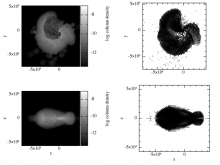
Abstract
During the merger of a black hole and a neutron star, baryonic mass can become unbound from the system. Because the ejected material is extremely neutron-rich, the r-process rapidly synthesizes heavy nuclides as the material expands and cools. In this work, we map general relativistic models of black hole-neutron star (BHNS) mergers into a Newtonian smoothed particle hydrodynamics (SPH) code and follow the evolution of the thermodynamics and morphology of the ejecta until the outflows become homologous. We investigate how the subsequent evolution depends on our mapping procedure and find that the results are robust. Using thermodynamic histories from the SPH particles, we then calculate the expected nucleosynthesis in these outflows while varying the level of neutrino irradiation coming from the postmerger accretion disk. We find that the ejected material robustly produces r-process nucleosynthesis even for unrealistically high neutrino luminosities, due to the rapid velocities of the outflow. Nonetheless, we find that neutrinos can have an impact on the detailed pat- tern of the r-process nucleosynthesis. Electron neutrinos are captured by neutrons to produce protons while neutron capture is occurring. The produced protons rapidly form low mass seed nuclei for the r-process. These low mass seeds are eventually incorporated into the first r-process peak at A~78, producing mainly Ge and Se. We consider the mechanism of this process in detail and discuss if it can impact galactic chemical evolution of the first peak r-process nuclei.